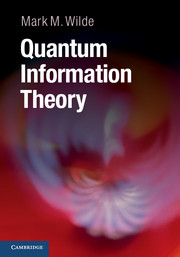Book contents
- Frontmatter
- Contents
- How To Use This Book
- Acknowledgments
- Part I Introduction
- Part II The Quantum Theory
- Part III Unit Quantum Protocols
- Part IV Tools of Quantum Shannon Theory
- 9 Distance Measures
- 10 Classical Information and Entropy
- 11 Quantum Information and Entropy
- 12 The Information of Quantum Channels
- 13 Classical Typicality
- 14 Quantum Typicality
- 15 The Packing Lemma
- 16 The Covering Lemma
- Part V Noiseless Quantum Shannon Theory
- Part VI Noisy Quantum Shannon Theory
- Appendix A Miscellaneous Mathematics
- Appendix B Monotonicity of Quantum Relative Entropy
- References
- Index
15 - The Packing Lemma
from Part IV - Tools of Quantum Shannon Theory
Published online by Cambridge University Press: 05 May 2013
- Frontmatter
- Contents
- How To Use This Book
- Acknowledgments
- Part I Introduction
- Part II The Quantum Theory
- Part III Unit Quantum Protocols
- Part IV Tools of Quantum Shannon Theory
- 9 Distance Measures
- 10 Classical Information and Entropy
- 11 Quantum Information and Entropy
- 12 The Information of Quantum Channels
- 13 Classical Typicality
- 14 Quantum Typicality
- 15 The Packing Lemma
- 16 The Covering Lemma
- Part V Noiseless Quantum Shannon Theory
- Part VI Noisy Quantum Shannon Theory
- Appendix A Miscellaneous Mathematics
- Appendix B Monotonicity of Quantum Relative Entropy
- References
- Index
Summary
The packing lemma is a general method for one party to pack classical messages into a Hilbert space so that another party can distinguish the packed messages. The first party can prepare an ensemble of quantum states, and the other party has access to a set of projectors from which he can form a quantum measurement. If the ensemble and the projectors satisfy the conditions of the packing lemma, then it guarantees the existence of a scheme by which the second party can distinguish the classical messages that the first party prepares.
The statement of the packing lemma is quite general, and this approach has a great advantage because we can use it as a primitive in many coding theorems in quantum Shannon theory. Examples of coding theorems that we can prove with the packing lemma are the Holevo–Schumacher–Westmoreland (HSW) theorem for transmission of classical information over a quantum channel and the entanglement-assisted classical capacity theorem for the transmission of classical information over an entanglement-assisted quantum channel (furthermore, Chapter 21 shows that these two protocols are sufficient to generate most known protocols in quantum Shannon theory). Combined with the covering lemma of the next chapter, the packing lemma gives a method for transmitting private classical information over a quantum channel, and this technique in turn gives a way to communicate quantum information over a quantum channel.
- Type
- Chapter
- Information
- Quantum Information Theory , pp. 388 - 400Publisher: Cambridge University PressPrint publication year: 2013

